Text
Content Page:
Except from the top 3 post’s the page is backwards in relation to the time order. Which means you need to start from the bottom and work up after reading the contextual document and the top. I have made a content page in the order of what is on the page from the top:
- My Specific Learning Disability
- Contextual Document and film
- The incredible community today
- Video simulation example of hearing impairment and severity
- Group Crit, 14th Dec
- Problem with the mic when reshooting and my solution
- Editing process in Final Cut Pro and After Effects
- Frames that need reshooting
- Flashback example
- The problems with my film
- Research: Cinematic technique - Fast cutting
- New Storyboard
- Pitch
- Practice: Steadicam
- One storyboard idea
- Research: Inspirational video
- Lecture: Pitch briefing 26th October
- Research: Influential quote
- Research: Gravity film
- Tutorial 2: 26th October
- Initial storyboard idea
- Research: Influences
- Mood board for model of the main characters
- Workshop: Editing in Final Cut Pro 19th October
- Lecture: Moving time & moving space 19th October
- Research and practice test: GIF
- Practice of focusing whilst videoing
- Research: Day for night cinematic technique
- Lecture: The moving camera- 12th October
- Workshop: Filming on DSLR 5th October
- Lecture: The moving subject 5th October
- Lecture: Sequencing & storytelling photography 28th September
- Research: Seeing at the speed of sound essay by Rachel Kolb
- Revised Initial Idea
- Research: Psychology Mcgurk Effect
- Tutorial 1: 5th October
- Initial Idea
- My initial influence: Personal experience
- Introduction to media and the moving image
0 notes
Text
Contextual Document and Film:
Moving Image: Look Straight At Me
Emily Osborne - 21281175
Initial Concept:
When looking at the three commercial client brief's and the personal brief options for this module I knew which one I was going to choose from the start.
Commercial Brief 1: The Ones with Stories a 5-minute film, with 5 still images.
When thinking about the theme The Ones with Stories I first thought…People who can’t get their story told? People whose stories don’t really matter to the greater population? Stories that need to be discovered? Everyday stories? Everyone has stories but what makes them interesting for other people to watch? Was it the dramatic storyline or the technical aspect of the story?
The idea for my project stemmed from a close personal experience I had when teaching a deaf girl to swim, she was only 5 years old but had already taught herself a valuable life skill which was lip reading. From when I was told she was deaf I had already started to build barriers worrying about how I would communicate, however, she broke these down with the ability to read lips to conquer my inability to use sign language. She had inspired me to start learning sign language, to help break down the barrier for other deaf people in the future who cannot lip read. She inspired my whole film however originally, I was going to look at the life of a profoundly deaf person and how they adapt their life. However, once developing my ideas with extensive research, I found the right story line for my drama style documentary reconstruction piece.
Development of Ideas:
Critical Analysis of Seeing at the Speed of Sound Essay by Rachel Kolb:
This essay was a way for me to evaluate some secondary research of a personal account through years of someone’s life with no hearing. Lip reading is ‘essentially a skill of trying to grasp with one sense the information that was intended for another’(R. Kolb, 2017). Rachel has put this in such a clever and simple way. I have learnt a lot from the essay, something I really didn’t think about with lip reading is the darkness and the difficulties that can arise when trying to lip read. It’s given me a true insight into a documentary style approach, which otherwise would not be possible. Rachel is commonly asked how she learnt to lip read, she would usually answer “practice, like how you learn to walk” (R. Kolb, 2017). But as a person with able hearing I struggle to believe it was that easy, it's her only option to adapt to get by. Rachel is very influential she says “self-confidence fuels the desire to practice and protects against the degradation of communication breakdown” (R. Kolb, 2017), she could have just given up and learnt sign language, but she pushed her skills so she didn’t limit her social possibilities. She can have conversations with anyone even if they are a bit disjointed. Rachel has shared with us problems that she faces with lip reading especially when reading the minutest changes in the muscles of the face. People that are impossible for Rachel and most likely most lip readers to read are: “people with thin lips, people who mumble, people who speak from the back of their throats, people with inexpressive faces, people who talk too fast, people who laugh a lot, tired people who slur their words, children with high babyish voices, men with moustaches or beards, people with any sort of accent” (R. Kolb, 2017). She also goes on to say she even struggles with people who try too hard to over enunciate everything as it distorts the natural lip movements. I will use this essay when thinking of the film and how to frame it. Looking at everyday task and how they’ve been adapted and the emotional factors behind being deaf.
Critical Analysis of the Psychological McGurk Effect:
The McGurk Effect is a mental interpretation that shows the relationship and connection between hearing & vision in speech perception. It’s said that the visual information a person sees changes when they hear the sound. In the video example at first you hear ‘BAA’ then the visual element changes and you hear ‘FAA’ even though the audio remained the same. This is an example of the psychological effect where the visual information that you’ve just gained creates a mental interpretation. (Faculty ,2017) This is why is can be so hard for someone to lip read, especially if they’re partially deaf and if they aren't able to physically see the person they’re talking to, as they may get phonics mixed up. “Only about 30 to 45 percent of the English language can be understood through lip reading alone. Interpreting facial cues, body language, and context to figure the rest out” (L. Callis, 2016). This is why it is so important for people to look straight at each other when talking.
Critical Analysis of a Day Through a Deaf Persons Eyes Video:
This is a video that has been put on YouTube (R. Soudakoff, 2015), it has been all recreated for the purpose of the film. It shows various scenes with difficulties and people being arrogant to the girl’s personal deafness but in contrast it shows her in the deaf community signing with others and how easy it is for them to communicate to one another using sign language. For my main character I won’t actually be able to use an actual deaf girl so I will have to use an actor, and film it in this style reconstructing a real drama.
Critical Analysis of ‘Gravity’ Film:
Gravity (Gravity, 2013) is a film that has been produced in a very clever way to replicate the sound or more specifically the silence in space. There is no sound in space, it's a vacuum so sound cannot be transmitted though the atmosphere, but sound can be transmitted through elements, the science behind is in the film when the character’s grab or touch objects the vibrations travel through them to their ears. So they will get a muffled representation of that sound. When creating Gravity, the sound was recorded for surround sound and was recorded in 7:1. They struggled with an aspect of more futz the voices became the more realistic it was but the less emotion transmitted to the audience. Some of the sounds are critical for displaying the depth of emotion. This is something I can really take for my work and be influenced in the way they use the limits of no sound to their advantages.
Critical Analysis of What It’s Like To Have Autism Video Lets You Experience Sensory Overload Yourself Video:
This is a video which I have found very inspirational, it is a personal account about a disability and how they feel in situations, it’s also an awareness campaign. I am conceptually inspired as its been made in a way to make people aware of the disability and how the person actually feels and not to judge from what they see originally, it makes the viewer think about their actions. Technically I’m inspired about the sound element, where it focuses in on certain sounds, when the boy would also focus into that certain time of action where something is happening. It’s very clever in helping to give the viewer an understanding of what is going on.
Critical Analysis of my work-
Pre-Production:
With my lack of knowledge and experience in moving image and using a DSLR to film, I had to do a lot of pre-production before I could even start doing test shoots for my film. This included research and practice shoots in to various ways to focus such as; manual focusing continuously, set focus and maintain distance, high aperture, auto focus FlexiZone and auto focus Tracking. I also decided to buy a stabilizer as my first few scenes the camera would be on the move a lot but I didn’t want too much camera shake. I had to get use to this and do many practice shoots walking at different speeds and different heights.
In my pitch to the class I had to sell my idea to everyone. Giving them an inkling of what was going on but not giving everything away. I explained the theme of my project being inspiration and how I was going to portray this and why it was important to myself. The second theme was awareness of hearing impairments. I then moved on to the approach I was going to take throughout the project this included my hypothesis before filming which was “to create a short film which shows an inspirational character which has learnt a skill that is so important in life, a skill to communicate, in a slightly different way to us but using her working senses to her strengths.” I also spoke about the equipment, angles and shots I intended to use and why. I then moved on to the content and structure, as well as the target audience. I also briefly addressed potential problems which I could come across.
Real Life Stories: My work is comprised of two real stories which I have then put together in the style of a reconstruction in a drama. The first is my personal experience of the little girl I taught who could lip-read and taught herself this life skill so she wasn’t so isolated from the rest of the community. She could still communicate with people who didn’t know sign language as she had learnt a very difficult skill which breaks that barrier. The second real life story I researched was about a deaf man called Timothy Green in Cincinnati that was hit by a drunken driver in a hit and run and left with serve injuries to his lower limbs. In his case the first witness who rushed to the scene to help actually knew sign language and realised Timothy was deaf and were able to communicate with him as well as keep him calm until the paramedics arrived (J. Baker, 2015).
This is my final story board that I created, it has frame timings and camera angles. I will use a Steadicam to create soft movement so the attention isn’t taken away from the main focus of the subject, however it may make a slight un-natural feel to the frame, as real life isn’t so smooth. I will also attempt to use various other filming techniques throughout the film to portray different emotions, such as out of focus to focused shots, overhead shots, fast cutting and hand held filming.










There are a few potential problem or risks with my project, but I addressed them early and worked out solutions so they wouldn’t affect my idea too much. There are ethical issues around the sensitive subject of a hearing impairment, however I ensured myself and the cast remained aware of the implications throughout the shoot to guarantee it would not cause offense in any way. As this film is creating awareness it will be done in a very respectable way. Another issue is access to a quiet road, so that I can do the filming shots of the girl on the on the road, and the shots of the car as it speeds down the road. I carried out various location scouts to find a quiet road, and once I found a suitable road I then back to that road various times of the day to check the traffic flow to find the best time to shoot. Unwillingness of models is always a possibility either before filming or whilst filming. I will have back up models in place, and have the models sign release forms so any footage can still be used if they do drop out.
Casting: I chose a female model for the main character on the evidence found in a psychology experiment carried out by S. Stuijfzand, looking at gender differences in empathic sadness towards persons of the same-versus other-sex during adolescences. They found that female targets received more affective empathy than male targets. (S. Stuijfzand et al, 2016). Therefore, to create a bigger impact and awareness it seemed appropriate for my main character to be a female. I also created a mood board for the looks I wanted for the other models as well; driver, bystander 1, bystander 2, bystander 3 and the paramedic.
Production:
I ordered the scenes into priority of what needed doing outside with the available daylight and with the use of the car as we only had untill 1pm. Also the road was at its quietest between 10am-2pm. Other timing implications to consider included the café giving me permission to film between 1pm-2:30pm as well as this daylight would go by 4pm. We ended up filming the morning waking up scenes in the evening.
Whilst shooting I went out with the intention to use various angles and cutting techniques to create different effects. I made sure to keep the pace of the story consistent throughout with the technical aspects and the visual aspects. I then also cut a sequence of fast cuts for the car crash scene to construct a dramatic scene. This technique was influenced by the famous shower scene from Psycho (Psycho, 1960), where you never actually see the whole drama, instead you see close up shots of one second as they keep switching instead of the actual stabbing, this intensifies the situation. Researchers at MIT discovered it takes ‘13 milliseconds for the human eye to process an image’ (A. Trafton, 2014).
Here are some photographs taken on the day by a second photographer to capture behind the scenes and my first experience filming and directing.
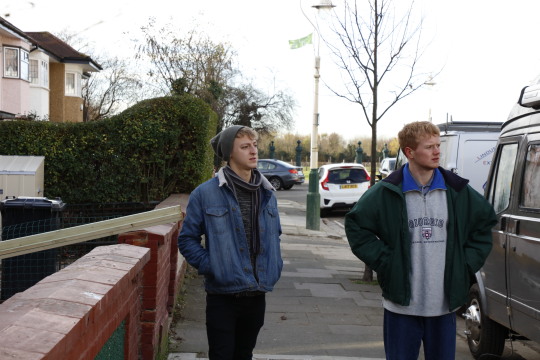
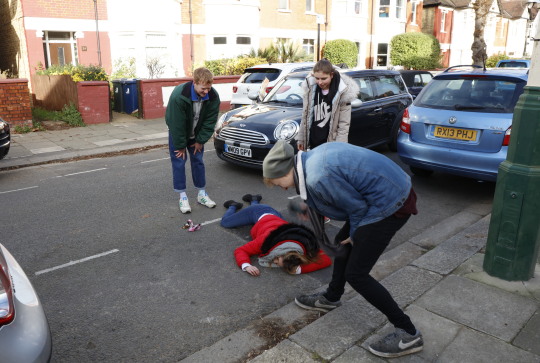
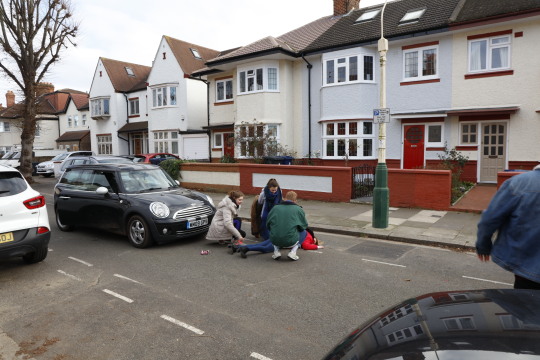
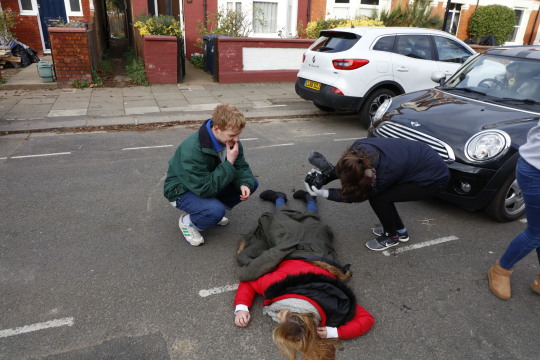
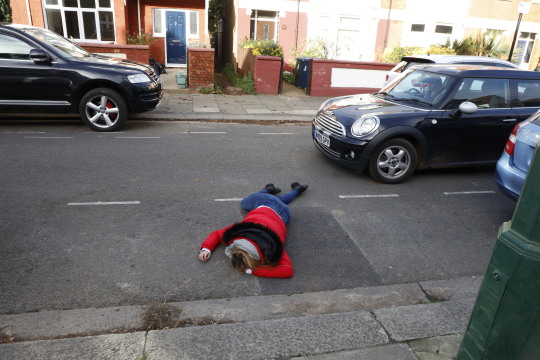
I imported all of the footage into Final Cut Pro and then put it into my timeline in the overall storyboard order so I could make sure I hadn’t missed any scenes. However, after I’d uploaded all the footage I realised some angles that I had filmed did not work. I was also missing a scene at the coffee shop to really set the scene of a wide angle scene, also I thought it would be best to reshoot the incoming text scene. After looking through the footage that I didn’t use in the timeline I worked out the shots I exactly need to pick up and re-organised this.
New pick-ups screenshots:
Scene 1a

Scene 1d


Scene 1f + 1g


Scene 1h + 3e


Post-Production:
I carried out the majority of my editing in Final Cut Pro until it came to the end when I needed to create the text bubble which I could not do in Final Cut and instead had to learn to use After Effects. I had previously watched a tutorial video on YouTube on how to create the text bubbles in After Effects (YouTube, 2017), which worked well for the grey bubble as this was an incoming text which someone else had. However, for when our girl was typing I wanted to animate the text in a typing style instead of just appearing. I knew I could do this back in Final Cut Pro using Typewriter.
I looked at Slumdog Millionaire (2008) for inspiration for a scene to show time had passed without the use of text as an aid. In Slumdog Millionaire there is a flashback scene where Jamel is slapped and it cuts to the interrogation room and then he’s slapped again and it cuts back to the game show. Then though out the scene it continues to show Jamels’ life history though flashbacks. There is a visual and an auditory element to aid the sense of the flashback for the viewer, this is something I will incorporate in my work for progressing to the final scene.
The important thing was to make sure the cuts were smooth for the viewer, the way I found to do this was to cut when on the move, when the character was crossing through the frame creating a natural body sweep cut. I carried this out throughout the progression of my film when the model was on the move to keep consistency.
My overall editing process for the visuals was:

The sound was a vital part for the success of the film and it was also another challenging aspect as I've not had much experience with audio and manipulating sound. My plans for the audio were very adventurous, however, if I wanted the film to have the impact I desired, it was a crucial element. The sound needed to give the viewer an insight into what it would be like to have a hearing impairment especially in a serious real life situation. I had various meetings with a sound engineer to find out the best way to apply the desired filters that I would need for the effect I wanted to create, and what software I would need to use. He also explained the best way to capture the audio on set would be to use a portable microphone called a Zoom H4n which I could plug into the input of my camera, or directly record sounds to an SD card.
Following feedback from a group critic, I decided I was going to apply a low pass filter on certain parts of footage when it was mid and close up shots or when the main character was in her home, her comfortable environment. Then the wider angle shots and the impact shot of the car crash would be the normal audio.
With the vibrating alarm on the wrist, I enhanced the sound to represent the feeling of this vibration on her skin and conducting through her bones. This was influenced by the film Gravity and the concept that sound can be transmitted through elements. The café scene has various cinematic cuts with each cut having the camera in a new place with a different distance from the road and the main character. I replicated this in the sound with different clips of audio with different levels of traffic noise also suggesting a passing of time.
A common auditory problem is tinnitus so during the clips where the audio represents the girls hearing there’s a high pitch sine wave representing the ‘ringing in the ears’ (NHS, 2015) caused by tinnitus. This was added as well as the filters in Logic Pro X after a tutorial with the sound engineer explaining how to achieve what I wanted. As well as this, I used the tutorial to learn how to use audio to create a larger impact during the scene of the collision. I then used these skills to layer up sounds of impacts, car engines and screeches captured using the Zoom H4 portable microphone during the shoot to create the overall sound of the accident.
The skills that I have learnt are going to be very useful in my future career as a photographer as technologies will continue to advance. If I hadn’t undertaken this module I would have no knowledge of moving image and the techniques of narrating, framing, directing, and all the post-production.
Dissemination of Work:
My 5-minute film is ideal for an online distribution over social media pages.
It would work best listening on headphones or some good speakers as the sound is stereo rather than mono so it sounds like the viewer is surrounded in the environment that they are watching. This was done intentionally so that it wasn’t as flat, and the viewer would become more empathic, even if they watch it on their phone it doesn’t matter they just don’t get the full potential sound quality. My target audience is anyone that has a limited view or knowledge of hearing impairments and to educate them on the issues encountered by both parties. It aims to show that some people are choosing to learn a certain skill to help not isolate them from everyone else, this skill being lip reading. By distributing this online its likely to reach the largest audience in the shortest amount of time.
Artist Statement:
‘Hearing loss occurs primarily when the inner ear or auditory nerve is damaged or when sound waves cannot reach the inner ear’ (U.Mueller et al, 2017) people lose the ability to hear high frequency sounds especially letters such as ‘f,h,s’ or experience complete deafness which is also known as being proudly deaf. This film summarises the struggles that someone with a hearing impairment may experience, however it also shows the importance of awareness in our actions and how we can help others. “Blindness separates people from things; deafness separates people from people.” - Hellen Keller (T. Balkany et al, n.d p31). I wanted to portray the difficulty of having a hearing impairment in today’s society even when carrying out easy everyday tasks, what it may be like to try to find a companion and dealing with your emotions. After watching the film, it may give the viewer a realisation of how they take hearing for granted and how their own life would be impacted by the loss of hearing. Hopefully it will inspire the audience to build a community where everyone learns sign language in order to break down the barrier of communication between the hearing and the non-hearing community.
5 Still Images:
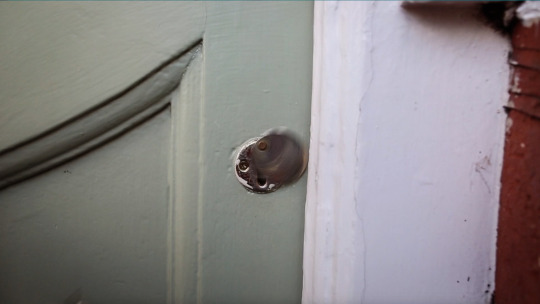

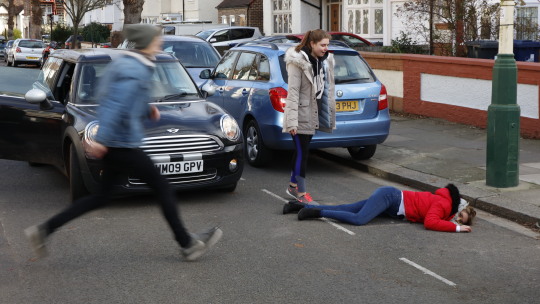


My Final Film: Look Straight at Me
Like mentioned in the dissemination of work, to get the full potential of the sound, please listen on good headphones or good speakers. Also please make sure the video is showing in the highest quality on youtube 1080p.
youtube
References:
A Day Through a Deaf Person's Eyes. (2015). [DVD] Rachel Soudakoff.
A Trafton (2014). In the blink of an eye. [online] MIT News. Available at: http://news.mit.edu/2014/in-the-blink-of-an-eye-0116 [Accessed 6 Nov. 2017].
Baker, J. (2015). Police: Drunk driver hits deaf pedestrian, flees. [online] Fox19.com. Available at: http://www.fox19.com/story/29011567/deaf-pedestrian-struck-seriously-hurt [Accessed 3 Oct. 2017].
Balkany, T. and Brown, K. (n.d.). The ear book. p.p31.
Faculty (2017). McGurk Effect. [online] Available at: http://www.faculty.ucr.edu/~rosenblu/VSMcGurk.html [Accessed 10 Oct. 2017].
Callis, L. (2016). Lip Reading Is No Simple Task. [online] HuffPost. Available at: https://www.huffingtonpost.com/lydia-l-callis/lip-reading-is-no-simple-task_b_9526300.html [Accessed 9 Oct. 2017].
Gravity (2013). Cuarón, A., Cuarón, A., Cuarón, J., Bullock, S., Clooney, G. and Harris, E. [online] IMDb. Available at: http://www.imdb.com/title/tt1454468/ [Accessed 21 Nov. 2017].
Kolb, R. (2017). "Seeing at the Speed of Sound" (via Passle). [online] Passle. Available at: http://rachel-kolb.passle.net/post/102c03y/seeing-at-the-speed-of-sound [Accessed 1 Oct. 2017].
Nhs (2015). Tinnitus. [online] Available at: https://www.nhs.uk/conditions/tinnitus/ [Accessed 11 Dec. 2017].
Mueller, U. and Yeager, M. (2017). Discover - Deafness and Hearing Loss Research. [online] Scripps.edu. Available at: https://www.scripps.edu/discover/deafness.html [Accessed 17 Dec. 2017].
Psycho. (1960). [film] Directed by A. Hitchcock. USA: Shamley Productions.
Slumdog millionaire. (2008). [film] Directed by D. Boyle and L. Tandan. USA: Warner Bros.
Soudakoff, R. (2015). A Day Through a Deaf Person's Eyes. [online] YouTube. Available at: https://youtu.be/ecmCHXZkTGI [Accessed 3 Oct. 2017].
S. Stuijfzand et al (2016). Gender Differences in Empathic Sadness towards Persons of the Same- versus Other-sex during Adolescence. Sex Roles, 75(9-10), pp.434-446.
What It’s Like To Have Autism Video Lets You Experience Sensory Overload For Yourself. (2016). [DVD] Youtube: Autism Safety Education & Training.
0 notes
Text
The incredible community of today:
youtube
This is a video filmed in America of a real life situation taking place at a Starbucks drive through. Where the driver didn't respond then the barista popped up on the screen and they were able to communicate using sign language. Starbucks trains there staff in America the very basics in sign language so that they can communicate and take orders of people from the deaf community. I think this is really inspirational and more companies should teach there employees this life skill as not only would it benefit the employee and the customer but also the business and sales.
0 notes
Text
Video simulation example of Hearing Impairment and the Severity:
youtube
This shows the auditory element of normal, mild, moderate, serve hearing loss whilst watching a popular tv programme. This is an educational video to influence peoples knowledge on hearing impairments. This will be useful for me when creating the right sound using low pass filters to simulate the deaf feeling.
0 notes
Text
Group Crit - 14th Dec:
Very Nerve-racking!!! But it went surprisingly well! I had mainly positive feedback, Carl mentioned about adding a heartbeat into when she's been hit, this is something i will look into further. Carl also said my shots are very film makery. Theres consistency between my technicality, the pace of the film, the story line, the shots, and stylisation through out.
0 notes
Text
Problem with the mic when reshooting and My Solution:
When reshooting the scene of the girl on the road when she says the important words “look straight at me” the mic did not work as the mic level was too low therefore her voice was not picked up. I worked out a way around this by using the old sound i had from another take i had, then I detached the audio and split each word up individually then had to make each word slightly longer or shorter then fill in the gap with background nose. This worked very successfully in the end.
0 notes
Text
Editing Process in Final Cut Pro and After Effects:
-Upload footage
-Rearrange footage
-Detach all audio
-Clip footage roughly
-Start at the beginning and create the smooth cuts
-Work through each clip
-Crop any frame if needed
-Reshoot frames
-Add new frames
-Detach audio on new clips
-Create smooth cuts on new clips
-Colour correct clips
-Apply crossfade on beginning and end of each audio clip
-Add transition
-Export
-Import in After Effects
-Import a png file of blue and grey text bubble
-Add Grey bubble and film to timeline
-Adjust position of bubble till in desired place
-Add text
-Adust duration
-Add Blue bubble to timeline
-Adjust duration
-DO NOT ADD TEXT
-Export
-Import in Final Cut Pro
-Add project
-Add Typewriter Text to the blue bubble
-Export
Thats the visuals done! Then i have to do that sound.
0 notes
Text
Frames that need reshooting:
This is from scene 1a, I had to reshoot this as the angle of the arm was wrong, I only noticed this when it cut to the next clip.

This is from scene 1d, this was a new frame as it would be a more interesting angle and easier imagine the sound of the zipper on the coat.

This is from scene 1d, I had to reshoot this as in the original she fumbled too much when grabbing the coat.

This is from scene 1f it was a new scene to set the location and show time passing.

This is from scene 1g it was a reshoot of the text message with a new angle over the shoulder so we can see the phone easier.

This is scene 1h it was reshoot as the original footage was too shaky, i reshoot using a tripod, and shot down low creating a more interesting angle.

This is scene 3e it was a new clip of a close up of her lying on the floor so i could add in other angles and cuts.

0 notes
Text
Flashback Example
At 2:17 mins its shows the split second where Jamel is slapped back into the interrogation room and then 2:33 he was slapped again resolving back to the game show. Then though out the scene it continues to show Jamels life history though flashbacks whilst he's either in the game show or being interrogated. you have the visual and the auditory element to aid the sense of the flashback, this is something i may look at for a summarising ending for my film.
youtube
0 notes
Text
The Problems with My Film:
I am creating a drama so the storyboard has to be so clear with timings and scripts etc. Preparation is SO IMPORTANT! Unfortunately i can't just go out and shoot. The casting also had to be right, i also had to get permission from the cafe to film there.
After that i had to organise the whole cast in the major scene which at times became quiet hectic. I had to make sure people weren't putting any personal belonging down that would later be in the shot.
Because I was conscious of keeping everyone as it was already a long day shooting i became quite flushed and missed a few angles that i wanted which would of added to the film so when edited I then realised. So i went back and reshot those bits so I had plenty to work with.
0 notes
Text
Research: Cinematic Technique- Fast Cutting
youtube
This technique will work perfectly for just showing the viewer little 1second clips of what is happening in the main car crash, so i don't actually have to recreate a whole crash, by using fast cutting it will look more realistic.
0 notes
Text
New Storyboard:
Scene 1: The girl locks the door (starts off with shot of the key locking the door, pan out to the girl turning around as she walks by and out the gate) follow walking down the path before she goes to cross (filming from behind with normal sound). Then she goes to cross the road and checks both way everything looks clear (filming from in front mid frame, with muffled sound).
Scene 2: Then as she goes to cross the road there is a speeding car coming down the road (filmed in a separate frame). The car gets closer ( vertigo effect?? all filmed in separate shots of her reaction and the car, the sound will be what she can hear) then it will end with her on the floor in the road.
Scene 3: Then shes on the road with people all around her ( over shoulder shot) and people aren’t talking to her instead they are talking about her ( sound cuts from what she can hear and what they can hear)
Scene 4: Paramedics arrive and they come to her eye level, she tells them she is deaf ( camera on the floor looking up slightly) they lipread and talk slowly calmly and friendly.
Scene 5: Closing scene????
Casting:
Main character- Meg
Driver- Kristi
Paramedic- Harry
Bystander 1 (calling the ambulance)- Hugo
Bystander 2- Zoe






0 notes
Text
Pitch:
Title: No more separating people from people – You will soon learn why I decided to use this as my title, and the relevance of this to my work.
Synopsis: I will create a 5 minute drama influenced from a unfortunate true story involving a profoundly deaf man who was hit by a car when crossing the road. I will be looking at a way to replicate this showing the sound element that deaf people feel and may hear in comparison to what we hear, also my character will have the use of lip reading which is a vital skill for people with serve hearing issues, and how they have used that skill to grasp information using one sense that was meant for another, a skill learnt so she didn’t isolate herself from the community who cannot use sign language.
I will now show you a GIF I have made which shows you a small insight into what it might be like, to try to have to read someone’s lips.
{Show the GIF}
Theme: My project is inspired from a personal experience of mine with a 5 year old girl who has influence and changed my views ever since. In the summer I was working as a swim teacher. In one of my lesion’s I had a little girl who was profoundly deaf which meant she had no hearing what so ever, she could not even hear the highest of pitches. But she could lip read, which broke down barriers that I had quickly started to build due to a lack of communication or knowing how to communicate with someone who is deaf. She was incredible at lip reading for the age of 5, if I’d been looking away when I said something important and she couldn’t see my lips, she would come up to me and tap me. I would repeat it and she would smile and go back to get ready to start swimming. She didn’t ask for any extra attention, she just got on with it, she was amazing. I thought about her for weeks after and the skill she taught herself at such a young age, so she didn’t isolate herself from the community.
My project will include the theme inspiration, showing the importance of the skill of lip reading in such an important situation. There will also be a theme of awareness which I hope to approach to show the importance of knowing to not just ignore people with hearing impairments, they are still human and they still feel the same way as us, sometimes their other senses can be heighten and in emergency situations their emotions can be running high.
Approach: My hypothesis before I start filming is to create a film which shows a inspirational character which has learnt a skill that is so important in life, a skill to communicate, in a slightly different way to us, using her working sense to her strengths. I want to also create awareness of this skill that people learn, and the difficulties that they face whilst carrying it out, yet they still manage to achieve this, and that for people that can hear, it is still possible to have a normal conversation with someone who lip reads.
I will use a Steadicam to create soft movement so the attention isn’t taken away from the main focus of the subject, however it may make a slight un-natural feel to the frame, as real life isn’t so smooth. I will also attempt to use various other filming techniques throughout the film to portray different effects and show different emotions, such as out of focus to focus shots, maybe overhead shot of her lying on the road, fast cutting, hand held filming and try the vertigo effect to give a sense of danger when the car is speeding towards her.
Content and Structure: My working assumption is that I will have 4 main scenes. Scene 1 will be the girl locking the door (starts off with shot of the key locking the door, then pan out to the girl turning around as she walks by and out the gate) follow girl as walking down the path before she goes to cross the road (filming from behind with normal sound). Then she goes to cross the road and checks both way everything looks clear (filming from in front mid frame shot, with muffled sound what she would hear).
Scene 2: Then as she goes to cross the road there is a speeding car coming down the road (which will be filmed in a separate frame). The car gets closer ( maybe use a vertigo effect as she clocks the car?? all filmed in separate shots of her reaction and the car, the sound will be what she can hear so muffled) then it will end with her on the floor in the road.
Scene 3: She’s on the road with people all around her ( over shoulder shot) putting a coat under her head and a coat over her etc.. but when people realize she’s deaf they don’t talk to her instead they are talking about her to each other ( sound cuts from what she can hear and what they can hear)
Scene 4: Paramedics arrive on scene and they come to her eye level, she tells them she is deaf ( camera on the floor looking up slightly) and she can lip read and the paramedics talk slowly calmly and are friendly.
Scene 5: Will be a closing scene which I haven’t confirmed yet.
I have selected my main character model, it will be a female model, as in a psychology experiment carried out by S. Stuijfzand looking at gender differences in empathic sadness towards persons of the same-versus other-sex during adolescences. They found that female targets received more affective empathy than male targets. I will also be using another actor to act as the main paramedic, then a few bystanders, and a driver.
Target Audience: My target audience would be to anyone that has a limited view or limited knowledge on hearing impairments and that it is scary for both of us. But in this century some people are choosing to learn a certain skill to help not isolate them from everyone else.
Potential Problems: There are a few potential problem or risks with my project, but I address to hit them straight on and work out solutions or ways around them that won’t affect my original idea too much. There are ethical issues around the sensitive subject of hearing impairment, however as long as I am sensible and do thorough research I will remain aware of what I am doing as to not course offense in any way. As this film is creating awareness it will be done in a very respectable way. Another issue is access to a quiet road, so that I can do the filming shots of the girl on the on the road, and the shots of the car as it speeds down the road. Unwillingness of models is always a possibility either before filming or whilst filming. I will have back up models in place, and I will also have the models sign release forms so any footage films can still be used if they do drop out.
Schedule:
9th November- PITCH
19th November- finished all filming
25th November- carried out and finished any pick ups
26th Nov- 11th December - carry out and finish all editing
17th December- finished workbook and contextual document
18th-19th December- allow time for checks and edits of workbook to be made
19th December- Personal deadline
21st December- FINAL DEADLINE
0 notes
Text
Practice: Steadicam
I decided to purchase a Orsda Handheld Steady Video Stabiliser Handle Grip Steadicam, to improve the stabilisation of my footage. It took me a long time to set this up and to find the centre of gravity, as the camera is so heavy and heavy in different place, even by moving the camera strap it sets off the balance, when i will start filming properly i will remove the strap. I will be using a prime lens when using the steady cam as if you zoom in or out it will also effect the centre point putting it out of balance. I adjusted the handle position, where the camera sits, the weight amount, how far the arm sits down, and the angle the arm sits to counter act the heavy weighted side of where the battery sits in the camera.
For this practice i used a 35mm lens which is quite light, and has a very nice low aperture.

This is the footage from the first few attempts of using the steady cam, I think it will take a lot of practice to get the full potential out of this piece of kit.
youtube
youtube
0 notes
Text
One Storyboard Idea:
Total film time 5 minutes-
Scene 1: Fast run of everyday tasks with no lipreading. Wake up - make breakfast - avoid a group conversation - go to work at a desk all day - go home - read a book - go to bed.
Scene 2: Wake up to the alarm on vibrating watch. The doorbell goes she is alerted by the house lights flickering. Answers the door, its a delivery guy ( split angle of two sides of the door before its opened?) he has a delivery, but she didn’t order anything... he tells him shes deaf as hes talking whilst eating something. He freezes and is in panic.. the vertigo effect on her. then she says she can lip read, but he over exaggerates all his words, so she says to talk normally, and they finish there conversation off normally.
Scene 3: Go to order a coffee but have difficulties with the person serving. Shot of her ordering over her shoulder -> Shot of the barista asking her if she want it to .....(takeaway)...., but this is mumbled as she turns away as she is saying it -> the girl asks her to repeat it -> the barista is frustrated which you can see in her face.
Scene 4: Lip reading in the dark. Close up of his face -> Slow motion { Extreme close up of his mouth -> Extreme close up of her squinting trying to understand -> Extreme close up of him talking -> Extreme close up her squinting -> Extreme close up of her hand on face -> Close up of his mouth then pan out.
Scene 5: ....?
0 notes
Text
Research: Inspirational Video
This is a video which I have found very very inspirational, it is a personal account about a disability and how they feel in situations, its also an awareness campaign. I am conceptually inspired as its been made in a way to make people aware of the disability and how the person actually feels and not to judge from what they see originally, it makes the viewer think about there actions.
Technically i’m inspired about the sound element, where it focuses in on certain sounds, when the boy would also focus into that certain time of action where something is happening. It helps to give us an understanding of what is going on.
youtube
0 notes
